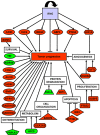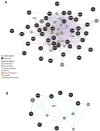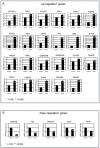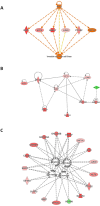Gene expression profiling of normal thyroid tissue from patients with thyroid carcinoma
- PMID: 27105534
- PMCID: PMC5045425
- DOI: 10.18632/oncotarget.8820
Gene expression profiling of normal thyroid tissue from patients with thyroid carcinoma
Abstract
Gene expression profiling (GEP) of normal thyroid tissue from 43 patients with thyroid carcinoma, 6 with thyroid adenoma, 42 with multinodular goiter, and 6 with Graves-Basedow disease was carried out with the aim of achieving a better understanding of the genetic mechanisms underlying the role of normal cells surrounding the tumor in the thyroid cancer progression. Unsupervised and supervised analyses were performed to compare samples from neoplastic and non-neoplastic diseases. GEP and subsequent RT-PCR analysis identified 28 differentially expressed genes. Functional assessment revealed that they are involved in tumorigenesis and cancer progression. The distinct GEP is likely to reflect the onset and/or progression of thyroid cancer, its molecular classification, and the identification of new potential prognostic factors, thus allowing to pinpoint selective gene targets with the aim of realizing more precise preoperative diagnostic procedures and novel therapeutic approaches.This study is focused on the gene expression profiling analysis followed by RT-PCR of normal thyroid tissues from patients with neoplastic and non-neoplastic thyroid diseases. Twenty-eight genes were found to be differentially expressed in normal cells surrounding the tumor in the thyroid cancer. The genes dysregulated in normal tissue samples from patients with thyroid tumors may represent new molecular markers, useful for their diagnostic, prognostic and possibly therapeutic implications.
Keywords: gene expression profile; hypoxia; microenvironment; oncogenes; thyroid cancer.
Conflict of interest statement
All the authors declare no conflict of interests.
Figures






References
-
- Ghossein R. Problems and controversies in the histopathology of thyroid carcinomas of follicular cell origin. Arch Pathol Lab Med. 2009;133:683–91. - PubMed
-
- Fassnacht M, Kreissl MC, Weismann D, Allolio B. New targets and therapeutic approaches for endocrine malignancies. Pharmacol Ther. 2009;123:117–41. - PubMed
-
- Kondo T, Ezzat S, Asa SL. Pathogenetic mechanisms in thyroid follicular-cell neoplasia. Nat Rev Cancer. 2006;6:292–306. - PubMed
MeSH terms
Substances
LinkOut - more resources
Full Text Sources
Other Literature Sources
Medical
Molecular Biology Databases

